Submitted:
23 March 2024
Posted:
25 March 2024
You are already at the latest version
Abstract
Keywords:
Introduction
Methodology
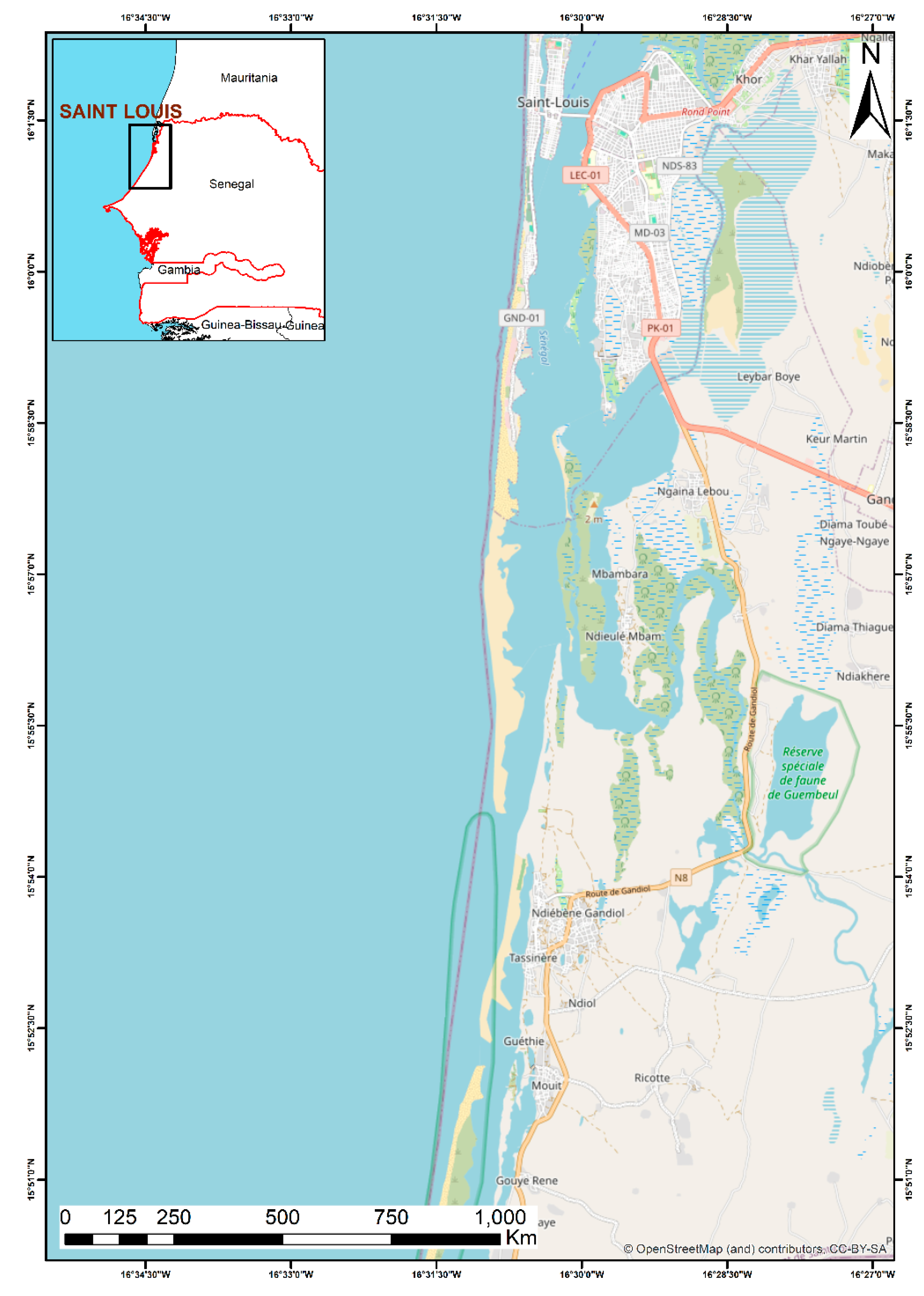
Vertical Land Motion
Digital Elevation Model Data and Extreme Coastal Water Level (ECWL) Data
Bathtub Inundation Model
Results
Discussion
Conclusion
References
- Woodruff, J.D., Irish, J.L., and Camargo, S.J. (2013). Coastal flooding by tropical cyclones and sea-level rise. Nature, 504, 44-51.
- Luijendijk, A., Hagenaars, G., Ranasinghe, R., Baart, F., Donchyts, G., & Aarninkhof, S. (2018). The state of the world’s beaches. Scientific reports, 8(1), 6641.
- Wang, L., Zhang, M., Wen, J, Chong, Z., Ye, Q., and Ke, Q. (2019). Simulation of extreme compound coastal flooding in Shanghai[J]. Advances in Water Science, 30(4): 546-555. [CrossRef]
- Vousdoukas, M. I., Clarke, J., Ranasinghe, R., Reimann, L., Khalaf, N., Duong, T. M., ... & Simpson, N. P. (2022). African heritage sites threatened as sea-level rise accelerates. Nature Climate Change, 12(3), 256-262. Nature Climate Change.
- Wu, P. C., Wei, M., & D’Hondt, S. (2022). Subsidence in coastal cities throughout the world observed by InSAR. Geophysical Research Letters, 49(7), e2022GL098477.
- Ohenhen, L. O., Shirzaei, M., & Barnard, P. L. (2024). Slowly but surely: Exposure of communities and infrastructure to subsidence on the US east coast. PNAS nexus, 3(1), pgad426.
- Liu, S. P., Shi, B., Gu, K., Zhang, C. C., Yang, J. L., Zhang, S., & Yang, P. (2020). Land subsidence monitoring in sinking coastal areas using distributed fiber optic sensing: a case study. Natural Hazards, 103, 3043-3061.
- Herrera-García, G., Ezquerro, P., Tomás, R., Béjar-Pizarro, M., López-Vinielles, J., Rossi, M., ... & Ye, S. (2021). Mapping the global threat of land subsidence. Science, 371(6524), 34-36.
- Li, P., Wang, G., Liang, C., Wang, H., & Li, Z. (2023). InSAR-derived Coastal Subsidence Reveals New Inundation Scenarios over the Yellow River Delta. IEEE Journal of Selected Topics in Applied Earth Observations and Remote Sensing.
- Meem, M. S., Islam, M. S., & Debnath, P. (2016). Subsidence in the coastal belt of Bangladesh and its implication to the coastal dynamics and ecosystem. Coastal and marine environment of Bangladesh. BAPA-BEN, 138-151.
- Chai, L., Xie, X., Wang, C., Tang, G., & Song, Z. (2024). Ground subsidence risk assessment method using PS-InSAR and LightGBM: a case study of Shanghai metro network. International Journal of Digital Earth, 17(1), 2297842.
- Higgins, S. A. (2016). Advances in delta-subsidence research using satellite methods. Hydrogeology Journal, 24(3), 587.
- Nienhuis, J. H., Törnqvist, T. E., Jankowski, K. L., Fernandes, A. M., & Keogh, M. E. (2017). A new subsidence map for coastal Louisiana. GSA Today, 27(9), 58-59.
- Noubissie, L. D., Birol, F., Onguene, R., Léger, F., Niño, F., & Naoussi, R. D. (2024). Virtual coastal altimetry tide gauges along the West African coast. Estuarine, Coastal and Shelf Science, 296, 108600.
- Zhao, S., Li, P., Li, H., Zhang, T., & Wang, B. (2023). Monitoring and Comparative Analysis of Hohhot Subway Subsidence Using StaMPS-PS Based on Two DEMS. Remote Sensing, 15(16), 4011.
- Shi, X., Zhang, S., Jiang, M., Pei, Y., Qu, T., Xu, J., & Yang, C. (2021). Spatial and temporal subsidence characteristics in Wuhan (China), during 2015–2019, inferred from Sentinel-1 synthetic aperture radar (SAR) interferometry. Natural Hazards and Earth System Sciences, 21(8), 2285-2297.
- Fajrin, F., Almegi, A., Bakari, A., Ramadhan, R., & Antomi, Y. (2021). Enviromental monitoring of land subsidence in the coastal area of padang city using sentinel 1 sar dataset. Sumatra Journal of Disaster, Geography and Geography Education, 5(1), 30-34.
- Wang, J., Gao, W., Xu, S., & Yu, L. (2012). Evaluation of the combined risk of sea level rise, land subsidence, and storm surges on the coastal areas of Shanghai, China. Climatic change, 115, 537-558.
- Raucoules, D., Le Cozannet, G., Wöppelmann, G., De Michele, M., Gravelle, M., Daag, A., & Marcos, M. (2013). High nonlinear urban ground motion in Manila (Philippines) from 1993 to 2010 observed by DInSAR: implications for sea-level measurement. Remote sensing of environment, 139, 386-397.
- Shirzaei, M., & Bürgmann, R. (2018). Global climate change and local land subsidence exacerbate inundation risk to the San Francisco Bay Area. Science advances, 4(3), eaap9234.
- Shirzaei, M., Freymueller, J., Törnqvist, T. E., Galloway, D. L., Dura, T., & Minderhoud, P. S. (2021). Measuring, modelling and projecting coastal land subsidence. Nature Reviews Earth & Environment, 2(1), 40-58.
- Fang, J., Nicholls, R. J., Brown, S., Lincke, D., Hinkel, J., Vafeidis, A. T., ... & Shi, P. (2022). Benefits of subsidence control for coastal flooding in China. Nature Communications, 13(1), 6946.
- Hsiao, S. C., Fu, H. S., Chen, W. B., Chang, T. Y., Wu, H. L., & Liang, T. Y. (2022). Assessment of future possible maximum flooding extent in the midwestern coastal region of Taiwan resulting from sea-level rise and land subsidence. Environmental Research Communications, 4(9), 095007.
- Wang, G., Li, P., Li, Z., Liu, J., Zhang, Y., & Wang, H. (2024). InSAR and machine learning reveal new understanding of coastal subsidence risk in the Yellow River Delta, China. Science of The Total Environment, 170203.
- Simms, A. R., Anderson, J. B., DeWitt, R., Lambeck, K., & Purcell, A. (2013). Quantifying rates of coastal subsidence since the last interglacial and the role of sediment loading. Global and planetary change, 111, 296-308.
- Du, Y., Feng, G., Liu, L., Fu, H., Peng, X., & Wen, D. (2020). Understanding land subsidence along the coastal areas of Guangdong, China, by analyzing multi-track MTInSAR data. Remote Sensing, 12(2), 299.
- Zhong, W., Chu, T., Tissot, P., Wu, Z., Chen, J., & Zhang, H. (2022). Integrated coastal subsidence analysis using InSAR, LiDAR, and land cover data. Remote Sensing of Environment, 282, 113297.
- Arikawa, T., Muhari, A., Okumura, Y., Dohi, Y., Afriyanto, B., Sujatmiko, K. A., & Imamura, F. (2018). Coastal subsidence induced several tsunamis during the 2018 Sulawesi earthquake. Journal of Disaster Research, 13(Scientific Communication), sc20181201.
- Cissé, C.O.T., Brempong, E.K, Taveneau, A., Almar, R., Sy, B.A and Angnuureng, D.B. (2022a). Extreme coastal water levels with potential flooding risk at the low-lying Saint Louis historic city, Senegal (West Africa). Front. Mar. Sci. 9:993644. [CrossRef]
- Cissé, C. O. T., SY, B., DIA, A. T., Taveneau, A., SY, B. A., (2022b) – Mapping flood-prone areas based on an extreme water level of centennial occurrence on a low sandy barrier beach (Langue de Barbarie), in line with the urban site of Saint-Louis, Senegal. Review of social sciences university Peleforo Gon Coulibaly de Korhogo, Côte D’Ivoire, n°3, december, p.185-201.
- Ingebritsen, S. E., & Galloway, D. L. (2014). Coastal subsidence and relative sea level rise. Environmental Research Letters, 9(9), 091002.
- SY, A.A. (2013). Sediment dynamics and current risks in the Saint-Louis-Gandiol axis, littoral Nord du Sénégal, Doctoral thesis in geography, Gaston Berger University (UGB), 333 p.
- SY, A.B., SY, A.A., Bodian, A., Faye C.A.T, Niang, S., DIOP, M., Ndiaye, M. (2015). «Breach" opened on the Langue de Barbarie in Saint-Louis Sketch of the results of a hasty development project, L’Harmattan, 136 p.
- Sy B. A., Bilbao I. A., Sy A .A, Perez I. S., Rodriguez Valido S. (2013). Results of the 2010-2012 monitoring of the evolution of the breach opened on the Langue de Barbarie in Senegal and its consequences. Physio-Geo, 7 (1), 223-242.
- Mancini, F., Grassi, F., & Cenni, N. (2021). A workflow based on SNAP–StaMPS open-source tools and GNSS data for PSI-Based ground deformation using dual-orbit sentinel-1 data: Accuracy assessment with error propagation analysis. Remote Sensing, 13(4), 753.
- Rocca, F., Prati, C., Monti Guarnieri, A., & Ferretti, A. (2000). SAR interferometry and its applications. Surveys in Geophysics, 21, 159-176.
- Brempong, E. K., Almar, R., Angnuureng, D. B., Mattah, P. A. D., Avornyo, S. Y., Jayson-Quashigah, P. N., ... & Teatini, P. (2023). Future flooding of the Volta Delta caused by sea level rise and land subsidence. Journal of Coastal Conservation, 27(3), 24.
- Ndour, A., Laïbi, R. A., Sadio, M., Degbe, C. G., Diaw, A. T., Oyédé, L. M., ... & Sambou, H. (2018). Management strategies for coastal erosion problems in West Africa: analysis, issues, and constraints drawn from the examples of Senegal and Benin. Ocean & Coastal Management, 156, 92-106.
- Ndour, A., Ba, K., Almar, A., Almeida, P., Sall, M., Diedhiou, P. M., ... & Sy, B. (2020). On the natural and anthropogenic drivers of the Senegalese (West Africa) low coast evolution: Saint Louis beach 2016 COASTVAR experiment and 3D modeling of short term coastal protection measures. Journal of Coastal Research, 95(SI), 583-587.
- Taveneau, A., Almar, R., Bergsma, E. W., Sy, B. A., Ndour, A., Sadio, M., & Garlan, T. (2021). Observing and predicting coastal erosion at the Langue de Barbarie sand spit around Saint Louis (Senegal, West Africa) through satellite-derived digital elevation model and shoreline. Remote Sensing, 13(13), 2454.
- Faye, M. (2023). Final thesis: Impacts of coastal erosion on the vulnerability of the "Langue de Barbarie" population in Saint-Louis in a context of climate change: diagnosis and adaptation strategies, Master's thesis specializing in risk and disaster management, University of Liége, Belgium., 80p.
- Hanebuth, T. J., Kudrass, H. R., Linstädter, J., Islam, B., & Zander, A. M. (2013). Rapid coastal subsidence in the central Ganges-Brahmaputra Delta (Bangladesh) since the 17th century deduced from submerged salt-producing kilns. Geology, 41(9), 987-990.
- Bagheri-Gavkosh, M., Hosseini, S. M., Ataie-Ashtiani, B., Sohani, Y., Ebrahimian, H., Morovat, F., & Ashrafi, S. (2021). Land subsidence: A global challenge. Science of The Total Environment, 778, 146193.
- Becker, M., Papa, F., Karpytchev, M., Delebecque, C., Krien, Y., Khan, J. U., ... & Shum, C. K. (2020). Water level changes, subsidence, and sea level rise in the Ganges–Brahmaputra–Meghna delta. Proceedings of the National Academy of Sciences, 117(4), 1867-1876.
- Catalao, J., Raju, D., & Nico, G. (2020). InSAR maps of land subsidence and sea level scenarios to quantify the flood inundation risk in coastal cities: The case of Singapore. Remote Sensing, 12(2), 296.
- Burkett, V. R., Zilkoski, D. B., & Hart, D. A. (2002). Sea-level rise and subsidence: implications for flooding in New Orleans, Louisiana. In US Geological Survey Subsidence Interest Group Conference. US Geological Survey, Galveston, Texas (pp. 63-71).
- Fiaschi, S., & Wdowinski, S. (2020). Local land subsidence in Miami Beach (FL) and Norfolk (VA) and its contribution to flooding hazard in coastal communities along the US Atlantic coast. Ocean & Coastal Management, 187, 105078.
- Wdowinski, S., Oliver-Cabrera, T., & Fiaschi, S. (2020). Land subsidence contribution to coastal flooding hazard in southeast Florida. Proceedings of IAHS, 382, 207-211.
- Hoogland, T., Van den Akker, J. J. H., & Brus, D. J. (2012). Modeling the subsidence of peat soils in the Dutch coastal area. Geoderma, 171, 92-97.
- Abidin, H. Z., Andreas, H., Gumilar, I., & Wibowo, I. R. R. (2015). On correlation between urban development, land subsidence and flooding phenomena in Jakarta. Proceedings of IAHS, 370, 15-20.
- Aucelli, P. P. C., Di Paola, G., Incontri, P., Rizzo, A., Vilardo, G., Benassai, G., ... & Pappone, G. (2017). Coastal inundation risk assessment due to subsidence and sea level rise in a Mediterranean alluvial plain (Volturno coastal plain–southern Italy). Estuarine, Coastal and Shelf Science, 198, 597-609.
- Anzidei, M., Bosman, A., Carluccio, R., Casalbore, D., D'Ajello Caracciolo, F., Esposito, A., ... & Sepe, V. (2017). Flooding scenarios due to land subsidence and sea-level rise: a case study for Lipari Island (Italy). Terra Nova, 29(1), 44-51.
- Wang, J., Yi, S., Li, M., Wang, L., & Song, C. (2018). Effects of sea level rise, land subsidence, bathymetric change and typhoon tracks on storm flooding in the coastal areas of Shanghai. Science of the total environment, 621, 228-234.
- Irawan, A. M., Marfai, M. A., Nugraheni, I. R., Gustono, S. T., Rejeki, H. A., Widodo, A., ... & Faridatunnisa, M. (2021). Comparison between averaged and localised subsidence measurements for coastal floods projection in 2050 Semarang, Indonesia. Urban Climate, 35, 100760.
- Van Bijsterveldt, C. E., Herman, P. M., van Wesenbeeck, B. K., Ramadhani, S., Heuts, T. S., van Starrenburg, C., ... & Bouma, T. J. (2023). Subsidence reveals potential impacts of future sea level rise on inhabited mangrove coasts. Nature Sustainability, 6(12), 1565-1577.
- Antoniadis, N., Alatza, S., Loupasakis, C., & Kontoes, C. (2023). Land Subsidence Phenomena vs. Coastal Flood Hazard—The Cases of Messolonghi and Aitolikon (Greece). Remote Sensing, 15(8), 2112.
- Navarro-Hernández, M. I., Valdes-Abellan, J., Tomás, R., Tessitore, S., Ezquerro, P., & Herrera, G. (2023). Analysing the impact of land subsidence on the flooding risk: evaluation through InSAR and modelling. Water Resources Management, 37(11), 4363-4383.
- Jiang, H., Zhang, J., Liu, Y., Li, J., & Fang, Z. N. (2023). Does flooding get worse with subsiding land? Investigating the impacts of land subsidence on flood inundation from Hurricane Harvey. Science of the total environment, 865, 161072.
- Zhao, Q., Pan, J., Devlin, A., Xu, Q., Tang, M., Li, Z., ... & Pepe, A. (2021). Integrated analysis of the combined risk of ground subsidence, sea level rise, and natural hazards in coastal and Delta River Regions. Remote Sensing, 13(17), 3431.
- Sene, S., & Ozer, P. (2002). Evolution pluviométrique et relation inondations–événements pluvieux au Sénégal. Bulletin de la Société géographique de Liège, 42.
- Vischel T., Lebel Thierry, Panthou G., Quantin G., Rossi A., Martinet M. Le retour d'une période humide au Sahel ? : observations et perspectives. In : Sultan Benjamin (ed.), Lalou Richard (ed.), Amadou Sanni M. (ed.), Oumarou A. (ed.), Soumaré M.A. (ed.). Les sociétés rurales face aux changements climatiques et environnementaux en Afrique de l'Ouest. Marseille : IRD, 2015, p. 43-60. (Synthèses). ISBN 978-2-7099-2146-6.
- Nouaceur, Z. (2020). La reprise des pluies et la recrudescence des inondations en Afrique de l'Ouest sahélienne », Physio-Géo [En ligne], Volume 15 | 2020, mis en ligne le 13 avril 2020, URL : http://journals.openedition.org/physio-geo/10966. [CrossRef]
- Tran, A.V.; Brovelli, M.A.; Ha, K.T.; Khuc, D.T.; Tran, D.N.; Tran, H.H.; Le, N.T.(2024) .Land Subsidence Susceptibility Mapping in Ca Mau Province, Vietnam Using Boosting Models. Preprints, 2024011854. [CrossRef]
- Vachaud, G., Gratiot, N., et Tran Ngoc, T. D. (2020). « Ho Chi Minh City, from flooding to submersion … ». EchoGéo 52: http://journals.openedition.org/echogeo/19473. [CrossRef]
- Erban, L. E., Gorelick, S. M., & Zebker, H. A. (2014). Groundwater extraction, land subsidence, and sea-level rise in the Mekong Delta, Vietnam. Environmental Research Letters, 9(8), 084010.
- Takagi, H., Thao, N. D., & Anh, L. T. (2016). Sea-level rise and land subsidence: impacts on flood projections for the Mekong Delta’s largest city. Sustainability, 8(9), 959.
- Ruiz-Constán, A., Ruiz-Armenteros, A. M., Galindo-Zaldívar, J., Lamas-Fernández, F., Sousa, J. J., Sanz de Galdeano, C., ... & Gil, A. J. (2017). Factors determining subsidence in urbanized floodplains: evidence from MT-InSAR in Seville (southern Spain). Earth Surface Processes and Landforms, 42(14), 2484-2497.
- Ciszewski, D., & Sobucki, M. (2022). River response to mining-induced subsidence. Catena, 214, 106303.
- Kiss, T., Hernesz, P., Sümeghy, B., Györgyövics, K., & Sipos, G. (2015). The evolution of the Great Hungarian Plain fluvial system–Fluvial processes in a subsiding area from the beginning of the Weichselian. Quaternary International, 388, 142-155.
- Mazzotti, S., Lambert, A., Van der Kooij, M., & Mainville, A. (2009). Impact of anthropogenic subsidence on relative sea-level rise in the Fraser River delta. Geology, 37(9), 771-774.
- Andreas, H., Abidin, H. Z., Pradipta, D., Sarsito, D. A., & Gumilar, I. (2018). Insight look the subsidence impact to infrastructures in Jakarta and Semarang area; Key for adaptation and mitigation. In MATEC Web of Conferences (Vol. 147, p. 08001). EDP Sciences.
- Antonellini, M., Giambastiani, B. M. S., Greggio, N., Bonzi, L., Calabrese, L., Luciani, P., ... & Severi, P. (2019). Processes governing natural land subsidence in the shallow coastal aquifer of the Ravenna coast, Italy. Catena, 172, 76-86.
- Parmar, H., Yarahmadi Bafghi, A., & Najafi, M. (2019). Impact of ground surface subsidence due to underground mining on surface infrastructure: the case of the Anomaly No. 12 Sechahun, Iran. Environmental Earth Sciences, 78, 1-14.
- Lyu, H. M., Shen, S. L., Zhou, A., & Yang, J. (2020). Risk assessment of mega-city infrastructures related to land subsidence using improved trapezoidal FAHP. Science of the Total Environment, 717, 135310.
- Liu, S. P., Shi, B., Gu, K., Zhang, C. C., Yang, J. L., Zhang, S., & Yang, P. (2020). Land subsidence monitoring in sinking coastal areas using distributed fiber optic sensing: a case study. Natural Hazards, 103, 3043-3061.
- Li, M. G., Chen, J. J., Xu, Y. S., Tong, D. G., Cao, W. W., & Shi, Y. J. (2021). Effects of groundwater exploitation and recharge on land subsidence and infrastructure settlement patterns in Shanghai. Engineering Geology, 282, 105995.
- El Shinawi, A., Kuriqi, A., Zelenakova, M., Vranayova, Z., & Abd-Elaty, I. (2022). Land subsidence and environmental threats in coastal aquifers under sea level rise and over-pumping stress. Journal of Hydrology, 608, 127607.
- Diao S.M. (1992). Etude des aquifères alluviaux de la vallée du fleuve Sénégal (secteur Rosso-Dagana-Lac de Guiers). Dakar (SEN) ; Dakar : UCAD ; ORSTOM, 91 p. multigr. Mém. DEA : Géol. Appliquée : Hydrogéol., UCAD : Dakar. 1992/05/29.
- Hudnut K W 1995 Rev. Geophys (American Geophysical Union) Earthquake Geodesy and Hazard Monitoring. U.S. National Report to IUGG 1991-1994 33.
- Bock Y, Prawirodirdjo L, Genrich J F, Stevens C W, McCaffrey R, Subarya C, Puntodewo S S O and Calais E 2003 Crustal motion in Indonesia from global positioning system measurements J Geophys Res 108.
- Koudogbo F. N., Duro J, Arnaud A, Bally P, Abidin H. Z. and Andreas H 2012 Combined X-and L-band PSI analyses for assessment of land subsidence in Jakarta, Proc. SPIE, Remote Sensing for Agriculture, Ecosystems, and Hydrology XIV 853107.
- Solihuddin, T., Husrin, S., Mustikasari, E., Heriati, A., Kepel, T. L., Salim, H. L., ... & Dwiyanti, D. (2021, November). Coastal Inundation and Land Subsidence in North Coast of West Java: A New Hazard?. In IOP Conference Series: Earth and Environmental Science (Vol. 925, No. 1, p. 012015). IOP Publishing.
- Hu, B., Chen, J., & Zhang, X. (2019). Monitoring the land subsidence area in a coastal urban area with InSAR and GNSS. Sensors, 19(14), 3181.
- Nhantumbo, J, B., Dada, O.A, and Ghomsi, F.E.K. (2023). Sea Level Rise and Climate Change - Impacts on African Coastal Systems and Cities. [CrossRef]
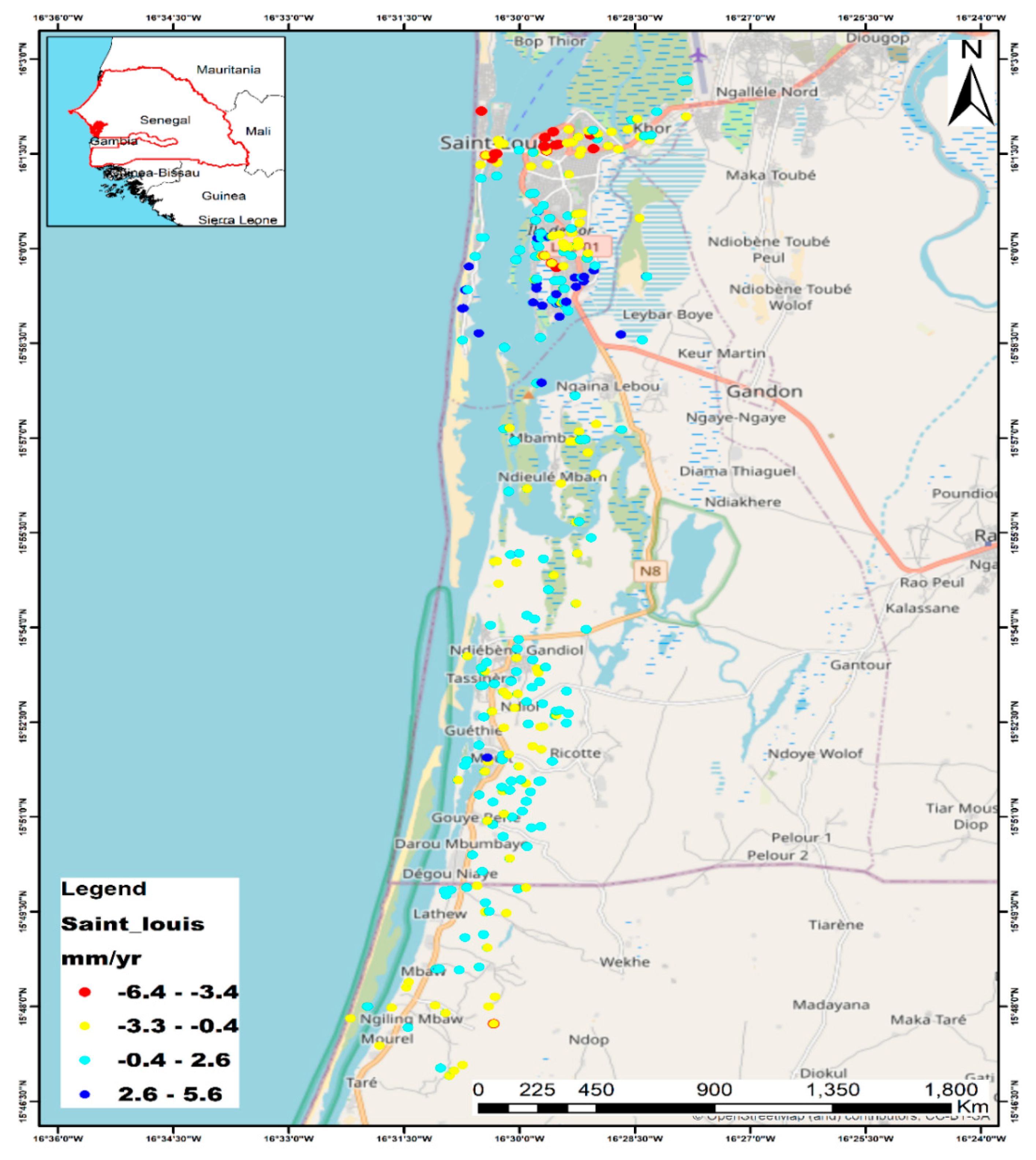
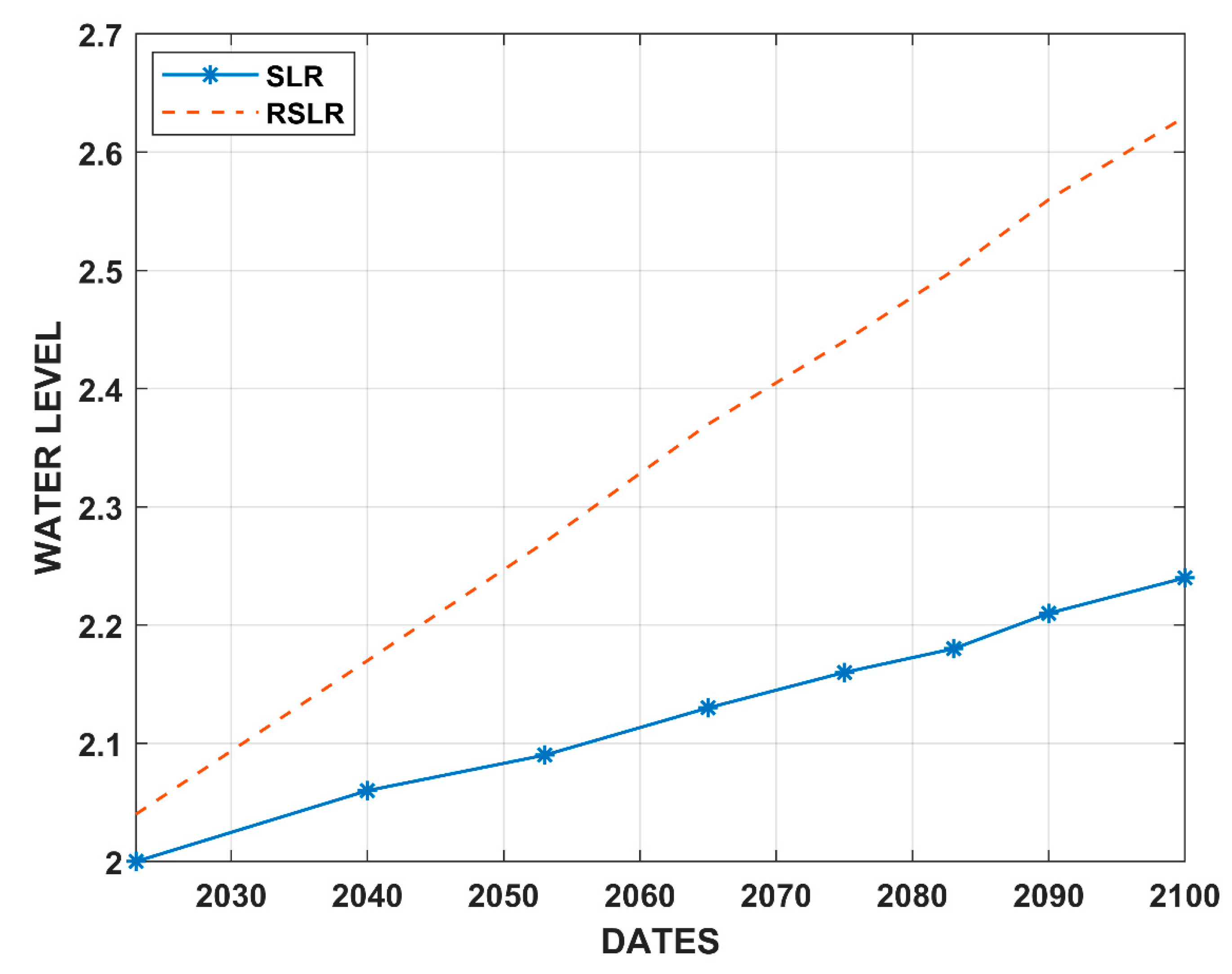
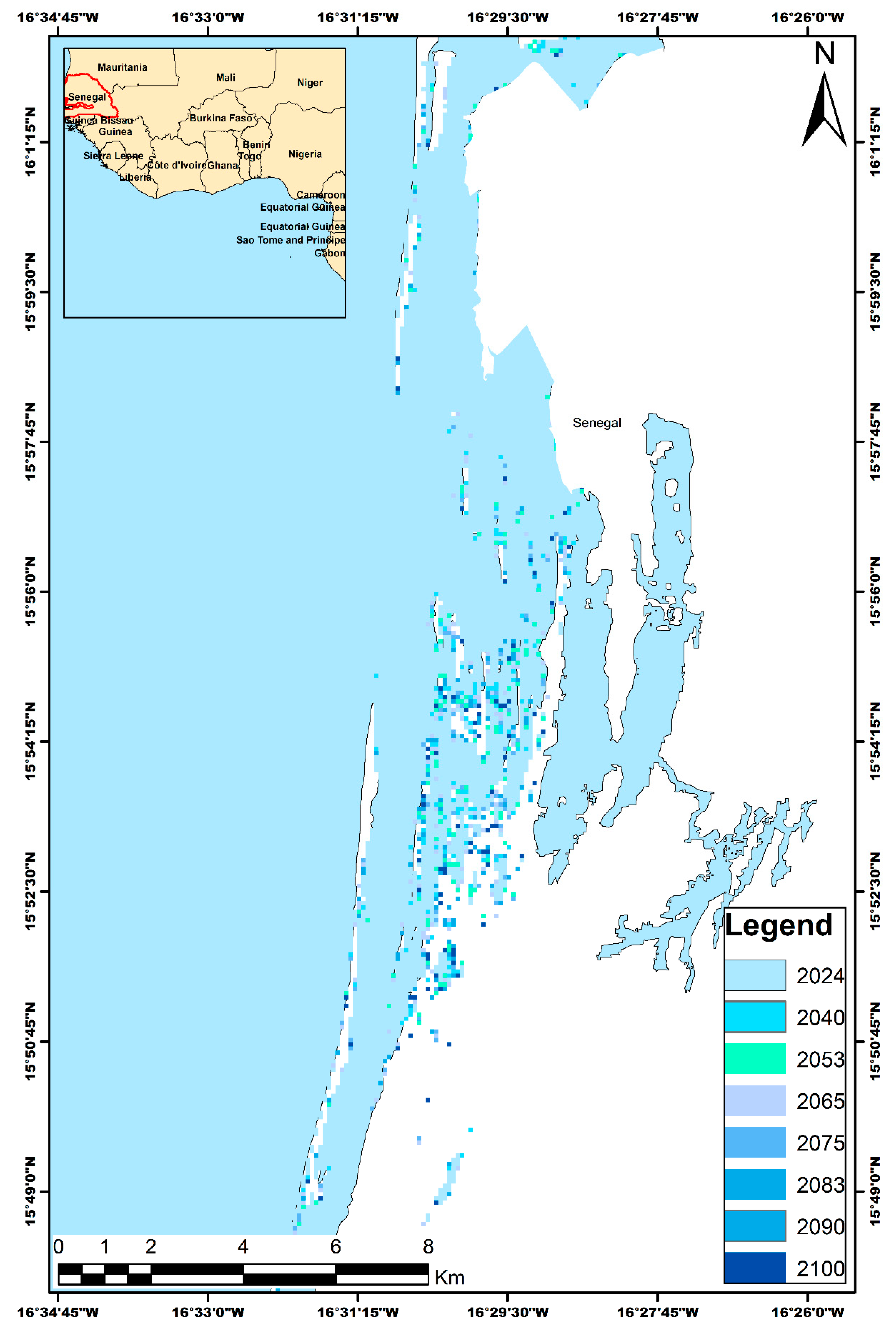
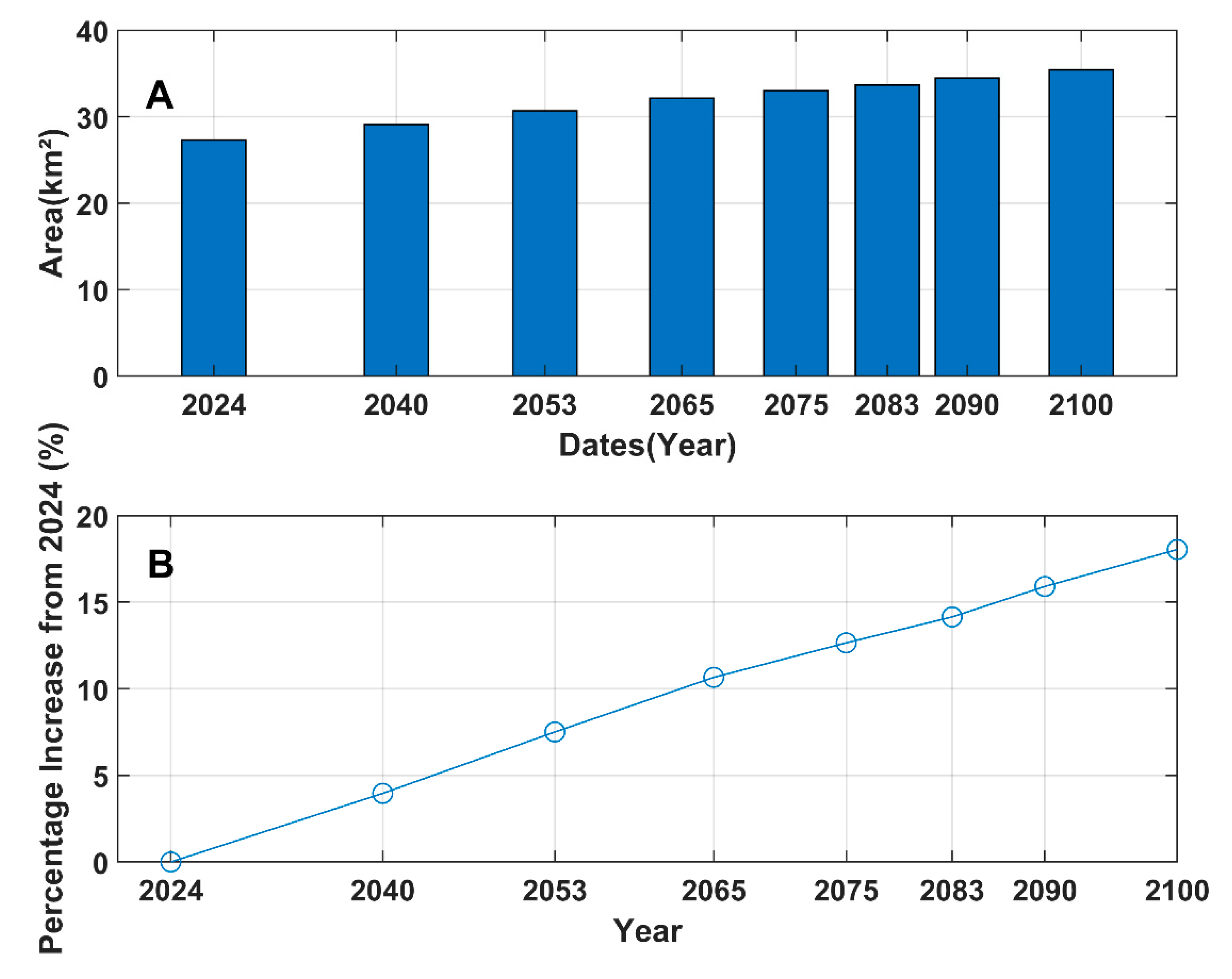
Disclaimer/Publisher’s Note: The statements, opinions and data contained in all publications are solely those of the individual author(s) and contributor(s) and not of MDPI and/or the editor(s). MDPI and/or the editor(s) disclaim responsibility for any injury to people or property resulting from any ideas, methods, instructions or products referred to in the content. |
© 2024 by the authors. Licensee MDPI, Basel, Switzerland. This article is an open access article distributed under the terms and conditions of the Creative Commons Attribution (CC BY) license (http://creativecommons.org/licenses/by/4.0/).




